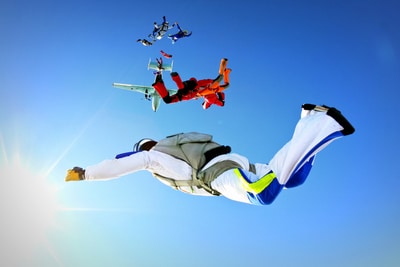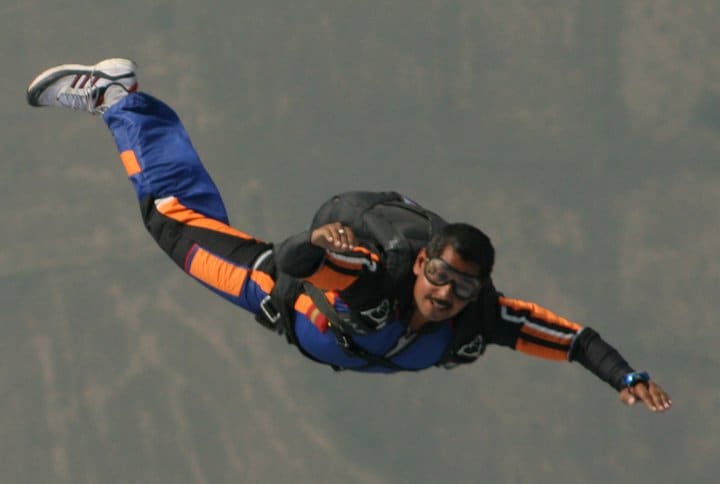What is Sky Diving
Skydiving also called parachuting is jumping from an aircraft and safely returning to the ground with the help of a parachute. Skydiving is an extremely popular adventure activity. Each year millions of people skydive all over the world enjoy the thrill of skydiving Besides being a recreational activity there are also professional careers that require skydiving. These include airborne soldiers from the military, firefighters and sometimes medical personnel.
At first look, skydiving or parachuting may seem an extremely dangerous but in reality accidents and fatalities are very rare. This is because of the rigourous training, well thought out procedures and modern equipment that are nowadays available. In most countries a skydiver will need to complete 5 jumps with at least one certified instructor before they can parachute alone. These jumps usually take place after detailed lessons on parachute safety and procedures are completed on the ground.
Skydiving Safety
Besides the training and assisted skydives the modern parachutist has excellent safety equipment. To begin with all skydivers carry a reserve parachute. This reserve parachute is checked and packed by a certified parachute rigger. This is almost like a guarantee that the reserve parachute will open. In addition to a reserve chute there is an additional level of safety, an - automatic activation device, AAD. This device opens the reserve parachute without the assistance of the parachutist in any way. AADs have saved many. Basically it detects an abnormal rate of descent and activates the reserve. There are cases where skydivers have collided, become unconscious and the AAD has saved their lives. Skydivers also carry an Altimaster with sudio and visual cues. This may seem superflous, but it is not. When a person is falling free, it is difficult to tell how close to the ground you are. It is absolutely necessary to open a parachute at a reasonable height above ground to make sure it fully deploys before you reach the ground. Because of the procedures and safety gear in place as well as a great safety record skydiving has its no wonder many people go skydiving. If you are thinking about going skydiving you should know some things about the sport. The first being what the risk is. Speaking statistically parachuting is a very safe sport.It's not the same as watching an IPL match in your drawign room but it's not supposed to be. Every year there are around 3 million skydives performed, of these 3 million jumps an average of 35 accidents happen. Most of these fatalities take place becasue of human error. This is not to say skydiving is not dangerous because it is. However, if people follow all the procedures and carry out all the checks, the odds of being injured or killed are extremely low. If you want to learn more about skydiving please contact the concerned Adventure Nation Guru and he will he happy to tell you what to do.
Skydiving Types
There are three types to pick from for your first jump. Tandem skydiving , you are attached to a skilled skydiver and are basically along for the ride. You will not worry about pulling the chord or controlling the parachute because the skilled skydiver will take care of all this for you. This is the most popular selection for first time skydivers. Static Line, this is the way parachuting for military airborne soldiers is done. You jump about 3,000 feet high with a chord hooked on a plane that pulls your parachute open.It's a bit more challenging than tandem skydiving because you have to land yourself. However, it's also a popular choice for first time skydivers. The final option available is Accelerated Freefall (AFF).This is for the first time skydivers who want every thrill there is. You jump with 2 instructors but have your own parachute and the responsibility of deploying your own parachute. These instructors check that you are performing everything safely and will stay with you until you open your parachute. Once your chute is open they will help you with landing by instructions on radio. Whatever method you pick for your first skydive, you will find skydiving an extremely thrilling experience.
A Bit of History
In the year was 1617 when Fauste Veranzio stepped to the edge of a four story tower in Venice, Italy we do not know exactly what was going through his mind at the time, but one thing is certain, shortly after stepping off the edge of that tower, he gently floated into the history books as the first man to utilize a Maximum Drag Decelerator, more widely known as a parachute. The credit for that concept goes to Leonardo Da Vinci, not to Faust. Faust had based the design for his parachute on a drawing done by Da Vinci in 1495.Since that fateful day in Venice, the use of parachute and parachute design has grown by leaps and bounds.Since Jean Pierre Blanchard first used a rigid frame parachute in 1785 to jump from his hot air balloon, when it inadvertently exploded, parachutes have been adding an extra level of safety to aviation as a life saving device. Today these are used in every corner of the world for everything from sport aviation to military special operations to recreational diving and more.he thrill of it. Besides being a recreational activity there are also professional careers that require skydiving. These include airborne soldiers from the military, firefighters and sometimes medical personnel.
Ideal Conditions
Skydiving seems like an extreme activity to many people, in good weather conditions the risks are very low. When weather conditions change, risks are compounded. That is why these daredevils must be very aware of the currents and conditions of this ocean of air.
Wind Conditions and Skydivers The factor that is most important to skydivers is wind conditions. Modern square parachutes have approximately a twenty mile per hour forward speed. This forward speed affords the skydiver great maneuverability.
On a day with no wind, a parachutist can go twenty miles per hour in whatever direction they prefer. When the wind is blowing, the wind speed and direction must be taken into consideration in order to land in the designated landing area. Just like a boat on a river, the currents of air will push a parachute in the direction that it is flowing.
There are three ways to figure out the best spot for the jump: Skydivers may use the winds aloft forecast provided by the National Weather Service. The skydiver may simply look at the movement of the clouds aloft for the upper winds. Looking at the wind socks and flags on the drop zone for surface wind speed and direction also works.
When to go
You can go skydiving at anytime of the year except the monsoon and rainy seasons. However for skydiving, timing is more important than month to indulge in this sport. It is recommended that on a clear day you may go skydiving either from 8:00 am to 10:00 am or from 4:00 pm till 5:00 pm. This is primarily because this is when the best light is available without you having the sun directly on your head.
Skydiving Clothes & Jumpsuits
Any clothes that you are comfortable in should be fine. Loose fitting clothes will likely allow you to be more comfortable during your skydive. Operators sometimes provide jumpsuits that cover your clothes. For the ladies, dresses or skirts are certainly not recommended. Most people wear shorts and a t-shirt in the warmer months. On cooler days, jeans and a sweatshirt will help keep you warm. If it’s cold, you can wear gloves.
Sneakers or similar soft soled shoes work best. Sandals, high-heels, flip-flops and other shoes that can easily come off can’t be worn. The shoes must be tight and able to stay on when freefalling at 120 MPH. Shoes or boots with hooks are also not permitted.
Jewelry could easily be lost during the skydive. If you are wearing jewelry, it’s best to give it to a friend or family member for the jump. Watches cannot be worn during the jump.
Helmets are a must for all tandem jumpers.If you have long hair, you should plan on pulling it back or putting it into a pony tail. Some people prefer to tuck their long hair inside their helmets.
Skydiving With Glasses
You must wear skydiving goggles. These goggles protect your eyes from the wind. If you wear prescription glasses, you can either jump without your glasses, or put our goggles over your glasses. If wear contacts, be sure to tell your instructor so they can be sure the goggles are tight against your face.








 Share Via
Share Via







